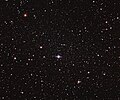Ficheru:Carina Dwarf Galaxy.jpg

Tamañu d'esta previsualización: 719 × 600 pixels. Otres resoluciones: 288 × 240 pixels | 576 × 480 pixels | 921 × 768 pixels | 1228 × 1024 pixels | 2456 × 2048 pixels | 3771 × 3145 pixels.
Ficheru orixinal (3771 × 3145 píxels, tamañu de ficheru: 5,64 MB, triba MIME: image/jpeg)
Historial del ficheru
Calca nuna fecha/hora pa ver el ficheru como taba daquella.
| Data/Hora | Miniatura | Dimensiones | Usuariu | Comentariu | |
|---|---|---|---|---|---|
| actual | 13:14 24 feb 2015 |  | 3771 × 3145 (5,64 MB) | FDMS4 | Reverted to version as of 14:03, 28 June 2011. |
| 03:00 24 feb 2015 |  | 3768 × 3144 (5,78 MB) | SteinsplitterBot | Bot: Image rotated by 180° | |
| 14:03 28 xun 2011 |  | 3771 × 3145 (5,64 MB) | Jmencisom |
Usu del ficheru
La páxina siguiente usa esti ficheru:
Usu global del ficheru
Estes otres wikis usen esti ficheru:
- Usu en af.wikipedia.org
- Usu en ar.wikipedia.org
- Usu en ca.wikipedia.org
- Usu en de.wikipedia.org
- Usu en el.wikipedia.org
- Usu en en.wikipedia.org
- Usu en es.wikipedia.org
- Usu en fi.wikipedia.org
- Usu en fr.wikipedia.org
- Usu en he.wikipedia.org
- Usu en id.wikipedia.org
- Usu en it.wikipedia.org
- Usu en ja.wikipedia.org
- Usu en ko.wikipedia.org
- Usu en mk.wikipedia.org
- Usu en nl.wikipedia.org
- Usu en no.wikipedia.org
- Usu en pl.wikipedia.org
- Usu en pt.wikipedia.org
- Usu en ro.wikipedia.org
- Usu en ru.wikipedia.org
- Usu en si.wikipedia.org
- Usu en sk.wikipedia.org
- Usu en tr.wikipedia.org
- Usu en uk.wikipedia.org
- Usu en vi.wikipedia.org
- Usu en www.wikidata.org